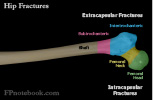II. Pathophysiology
- Images
- Extracapsular Hip Fracture
- Contrast with Femoral Neck Fracture
- Mechanism of injury
- High speed accident
- Fall from height
III. Diagnosis
- See Hip Fracture
-
Fracture line between greater and lesser trochanters
- Above Subtrochanteric Fracture
- Below Femoral Neck Fracture
IV. Management
- Evaluate for associated injuries (see pitfalls below)
- Closely manage fluid status
- Initial Resuscitation with isotonic crystalloid
- Type and Cross for 2 Units pRBC
- Continually reassess hemodynamic status
- Open reduction and internal fixation
- Surgery within 48 hours of injury
V. Complications
- Significant blood loss and hemodynamic instability
VI. Pitfalls
- Elderly are often significantly dehydrated
- Associated injuries are common
- Distal Radius Fracture
- Proximal Humerus Fracture
- Rib Fracture
- Spinal compression Fractures (esp. T12 and L1)
VII. Prognosis
- High mortality in first year: Up to 30%
VIII. References
- Gurr in Marx (2002) Rosen's Emergency Med, p. 655-60

